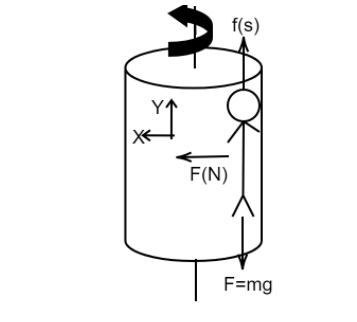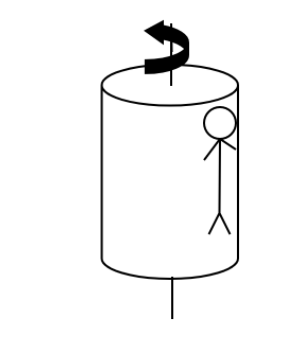
Answer
420k+ views
Hint: To solve (A) part of the question, we find all the forces acting on the body just so that the person is held against the wall. We find the normal force using a centrifugal force formula, which is further used to find the friction force between the wall and the person. We equate this with the weight of the person to find the time period. For the (B) part we simply substitute the values given in the question in the formula found earlier to get the solution. The units are then converted to per minute. Part (C) and (D) we apply the conditions given in the question to see how the forces vary.
Complete step by step answer:
(A)
The free-body diagram of the person is

For the person to be held against the wall the friction force action should be equal to the weight of the person.
Normal force action on the body is equal to the centrifugal force. The normal force is acting inwards.
${F_N} = \dfrac{{m{v^2}}}{R}$
Here, normal force is represented by ${F_N}$
Radius of the cylinder is represented by $R$
Mass of the person is represented by $m$
Velocity with which the person is being revolved is represented by $v$
Velocity is also equal to
$v = \dfrac{D}{t} = \dfrac{{2\pi R}}{T}$
Using this in normal force
${F_N} = \dfrac{m}{R} \times {(\dfrac{{2\pi R}}{T})^2} $
$ \Rightarrow {F_N} = \dfrac{{4{\pi ^2}Rm}}{{{T^2}}} $
Friction force is equal to
${f_s} = {\mu _s}{F_N} $
$ \Rightarrow {f_s} = {\mu _s} \times \dfrac{{4{\pi ^2}Rm}}{{{T^2}}} $
Here, Coefficient of friction is represented by ${\mu _s}$
Friction force acting upwards is represented by ${f_s}$
Weight of the person action downwards is equal to
$F = mg$
Here,
Weight of the person is represented by $F = mg$
Gravitational force is represented by $g$
From the friction force and weight balance equation, for the person to be held against the wall
$ {f_s} = F $
$ \Rightarrow {\mu _s} \times \dfrac{{4{\pi ^2}Rm}}{{{T^2}}} = mg $
$ \Rightarrow {T^2} = \dfrac{{{\mu _s}4{\pi ^2}R}}{g} $
$ \therefore T = \sqrt {\dfrac{{{\mu _s}4{\pi ^2}R}}{g}} $
Hence
\[T = \sqrt {\dfrac{{{\mu _s}4{\pi ^2}R}}{g}} \]
(B)
From the question
$ {\mu _s} = 0.400 $
$ R = 4m$
$ g = 10 $
Substituting in the formula of time period we get
$ T = \sqrt {\dfrac{{{\mu _s}4{\pi ^2}R}}{g}} $
$ \Rightarrow T = \sqrt {\dfrac{{0.4 \times 4{\pi ^2} \times 4}}{g}} $
$ \Rightarrow T = \dfrac{{2\pi \times 4}}{{10}} = 2.50rev/s = 2.50 \times 60rev/\min $
$ \therefore T = 150rev/\min $
(C) The gravitational force remains constant. (Static friction adjusts to support the weight) hence static friction and weight of a person are equal. The normal force increases. The person remains in motion held against the wall.
(D The gravitational force remains constant. Normal and friction forces decrease. The person slides relative to the wall and down the floor because the condition given is below the minimum centrifugal force required to keep the person against the wall.
Note: We can see that the gravitational force is always constant and nothing can change it. If the person is living down then it means the weight of the person is greater than the friction force acting between the person and the wall. Otherwise, the two forces are equal and the person is held against the wall.
Complete step by step answer:
(A)
The free-body diagram of the person is

For the person to be held against the wall the friction force action should be equal to the weight of the person.
Normal force action on the body is equal to the centrifugal force. The normal force is acting inwards.
${F_N} = \dfrac{{m{v^2}}}{R}$
Here, normal force is represented by ${F_N}$
Radius of the cylinder is represented by $R$
Mass of the person is represented by $m$
Velocity with which the person is being revolved is represented by $v$
Velocity is also equal to
$v = \dfrac{D}{t} = \dfrac{{2\pi R}}{T}$
Using this in normal force
${F_N} = \dfrac{m}{R} \times {(\dfrac{{2\pi R}}{T})^2} $
$ \Rightarrow {F_N} = \dfrac{{4{\pi ^2}Rm}}{{{T^2}}} $
Friction force is equal to
${f_s} = {\mu _s}{F_N} $
$ \Rightarrow {f_s} = {\mu _s} \times \dfrac{{4{\pi ^2}Rm}}{{{T^2}}} $
Here, Coefficient of friction is represented by ${\mu _s}$
Friction force acting upwards is represented by ${f_s}$
Weight of the person action downwards is equal to
$F = mg$
Here,
Weight of the person is represented by $F = mg$
Gravitational force is represented by $g$
From the friction force and weight balance equation, for the person to be held against the wall
$ {f_s} = F $
$ \Rightarrow {\mu _s} \times \dfrac{{4{\pi ^2}Rm}}{{{T^2}}} = mg $
$ \Rightarrow {T^2} = \dfrac{{{\mu _s}4{\pi ^2}R}}{g} $
$ \therefore T = \sqrt {\dfrac{{{\mu _s}4{\pi ^2}R}}{g}} $
Hence
\[T = \sqrt {\dfrac{{{\mu _s}4{\pi ^2}R}}{g}} \]
(B)
From the question
$ {\mu _s} = 0.400 $
$ R = 4m$
$ g = 10 $
Substituting in the formula of time period we get
$ T = \sqrt {\dfrac{{{\mu _s}4{\pi ^2}R}}{g}} $
$ \Rightarrow T = \sqrt {\dfrac{{0.4 \times 4{\pi ^2} \times 4}}{g}} $
$ \Rightarrow T = \dfrac{{2\pi \times 4}}{{10}} = 2.50rev/s = 2.50 \times 60rev/\min $
$ \therefore T = 150rev/\min $
(C) The gravitational force remains constant. (Static friction adjusts to support the weight) hence static friction and weight of a person are equal. The normal force increases. The person remains in motion held against the wall.
(D The gravitational force remains constant. Normal and friction forces decrease. The person slides relative to the wall and down the floor because the condition given is below the minimum centrifugal force required to keep the person against the wall.
Note: We can see that the gravitational force is always constant and nothing can change it. If the person is living down then it means the weight of the person is greater than the friction force acting between the person and the wall. Otherwise, the two forces are equal and the person is held against the wall.
Recently Updated Pages
How many sigma and pi bonds are present in HCequiv class 11 chemistry CBSE

Mark and label the given geoinformation on the outline class 11 social science CBSE

When people say No pun intended what does that mea class 8 english CBSE

Name the states which share their boundary with Indias class 9 social science CBSE

Give an account of the Northern Plains of India class 9 social science CBSE

Change the following sentences into negative and interrogative class 10 english CBSE

Trending doubts
Difference Between Plant Cell and Animal Cell

Difference between Prokaryotic cell and Eukaryotic class 11 biology CBSE

Fill the blanks with the suitable prepositions 1 The class 9 english CBSE

Differentiate between homogeneous and heterogeneous class 12 chemistry CBSE

Which are the Top 10 Largest Countries of the World?

One cusec is equal to how many liters class 8 maths CBSE

Give 10 examples for herbs , shrubs , climbers , creepers

The mountain range which stretches from Gujarat in class 10 social science CBSE

The Equation xxx + 2 is Satisfied when x is Equal to Class 10 Maths




